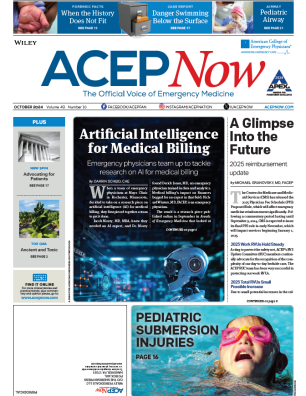Editor’s Note: The ACEP Clinical Policies Committee regularly reviews guidelines published by other organizations and professional societies. Periodically, new guidelines are identified on topics with particular relevance to the clinical practice of emergency medicine. This article highlights recommendations for community management of opioid overdose published by the World Health Organization (WHO) in 2014.
Opioid abuse, dependence, and overdose leading to death are epidemic. From 2001 to 2014, the number of deaths in the United States attributed to prescription opioids tripled, and deaths due to heroin increased fivefold; in 2014, nearly 30,000 deaths were attributed to opioids.1 This trend is especially concerning considering that naloxone, an antidote to treat respiratory depression due to opioid overdose, has been available for more than 50 years.
Emergency providers face the complications and consequences of opioid abuse and overdose every day, from emergency medical services first responders to police and firefighters to physicians in the emergency department. Recently, WHO published recommendations based on the best available evidence to prevent mortality associated with opioid overdose.2
A WHO guideline development group was established in 2013 to identify where advice was most needed to effectively treat opioid overdose. Clinical questions were developed in PICO (population, intervention, comparator, outcome) format, and available evidence was reviewed for each. Pooled evidence was rated according to Grading of Recommendations Assessment, Development, and Evaluation (GRADE) criteria, and four recommendations were set and ranked as either “strong,” meaning the group was confident that the recommendation was applicable in most situations, or “conditional,” denoting that there may be some situations in which the recommendation does not apply.3
WHO Recommendation #1
People likely to witness an opioid overdose should have access to naloxone and be instructed in its administration to enable them to use it for the emergency management of suspected opioid overdose.
Strength of recommendation: Strong
Although the evidence backing this recommendation is slim, the potential benefit of the intervention is so great that the level of this recommendation is listed as strong. The guideline defines “people likely to witness an opioid overdose” as people at risk of opioid overdose themselves, friends and families of those at risk of overdose, and those whose work may bring them into contact with overdose (this includes health care workers, police, emergency service workers, people providing accommodation to people who use drugs, peer educators, and outreach workers).
WHO Recommendation #2
Naloxone is effective when delivered by intravenous, intramuscular, subcutaneous, and intranasal routes of administration. Persons using naloxone should select a route of administration based on the formulation available, their skills in administration, the setting, and local context.
Pages: 1 2 3 | Single Page



One Response to “World Health Organization Recommendations for Community Management of Opioid Overdose Reviewed by ACEP Clinical Policies Committee”
February 8, 2016
Thomas BenzoniUmmmmm.
Most obvious recommendation missing?
To parallel-quote Surowiecki (http://www.newyorker.com/magazine/2002/12/09/the-talking-cure), it is not enough to fix our failings, we just have to stop committing them.
Why no proposals to stop misprescribing? Is it really possible we don’t know how to properly use these meds? Physicians just 20 years ago did; let’s ask them.